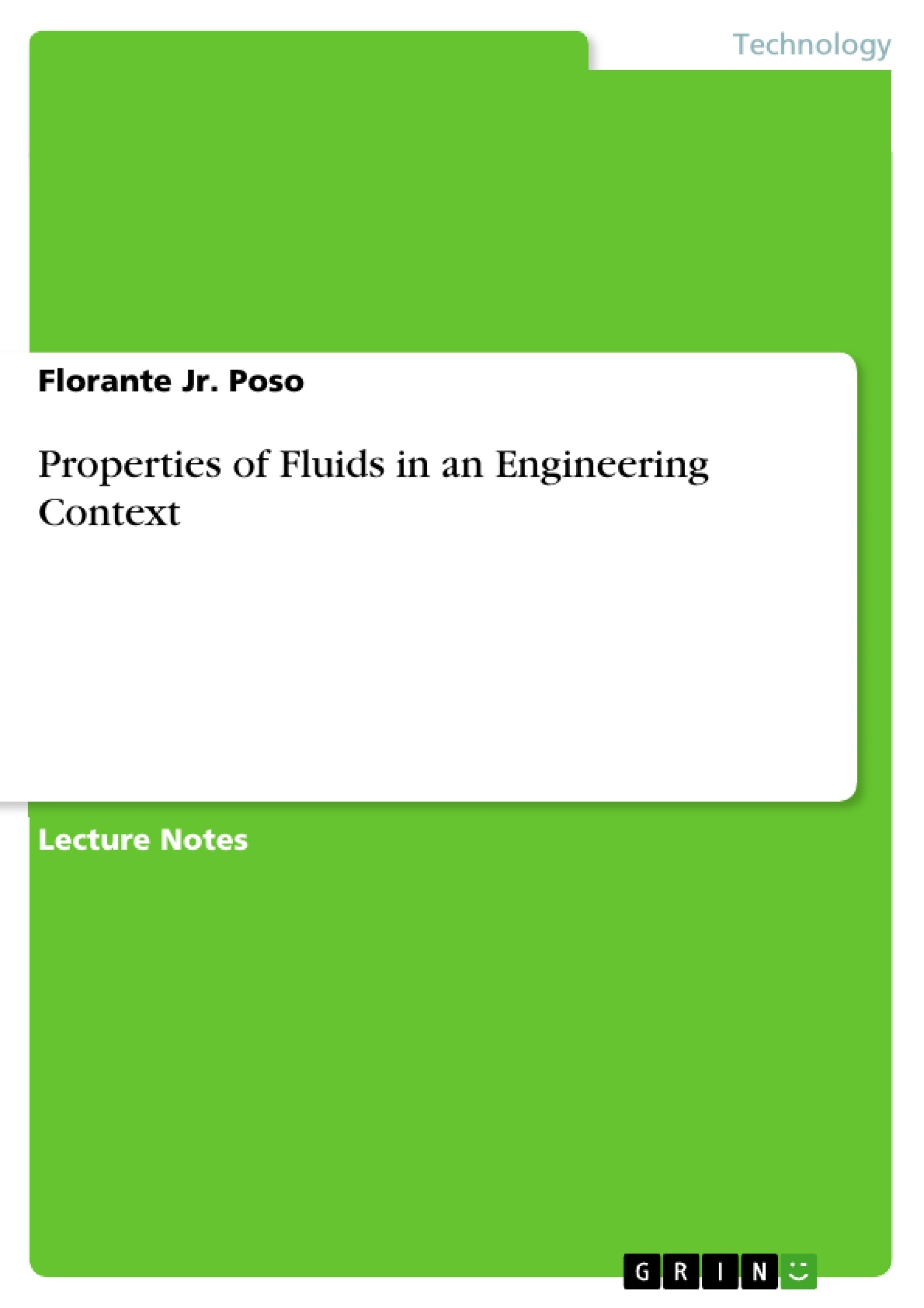This script discusses the different properties of fluids. In a general context, fluids are classified as either a liquid or gases, although in other textbooks, it also incorporates plasma as part of its scope. The coverage of this script is limited to the detail discussion of the fluid properties such as the density, viscosity, compressibility and elasticity, vapor pressure, surface tension and capillary rise or depression. Specific problems are presented with detailed solutions to guide the reader on the step by step procedure of solving in an engineering point of view.
The study of fluid mechanics is utilized in the field of engineering most specifically on engineering structures that incorporates the conveyance of fluids in the system. Pipelines and machines like turbines and engines also use the principles of fluid mechanics. Thus, it is cognizant to learn the basics of the properties of fluids in order to have a better grasp of the principles of fluids in application to engineering works. The units that were used in the illustrations are all in metric system.
Table of Contents
Introduction
Fluids
Properties of Fluids
Density
Mass Density
Problem 1.
Specific Weight
Relative Density
Problem 2.
Viscosity
Dynamic Viscosity (m)
Kinematic Viscosity (n)
Problem 3.
Compressibility and Elasticity
Problem 4.
Vapor Pressure
Surface Tension
Capillary Rise / depression
Problem 5:
Conclusion:
References:
Introduction
The eBook discusses the different properties of fluids. In a general context, fluids are classified as either a liquid or gases, although in other textbooks, it also incorporates plasma as part of its scope. The coverage of this eBook is limited to the detail discussion of the fluid properties such as the density, viscosity, compressibility and elasticity, vapor pressure, surface tension and capillary rise or depression. Specific problems are presented with detailed solutions to guide the reader on the step by step procedure of solving in an engineering point of view.
The study of fluid mechanics is utilised in the field of engineering most specifically on engineering structures that incorporate the conveyance of fluids in the system. Pipelines and machines like turbines and engines also use the principles of fluid mechanics. Thus, it is cognizant to learn the basics of the properties of fluids in order to have a better grasp of the principles of fluids in application to engineering works. The units that were used in the illustrations are all in metric system.
Fluids
“Fluid mechanics is a branch of physics concerned with the mechanics of fluids (liquids, gases, and plasmas) and the forces on them.”[1]
“Fluids are divided into liquids and gases. A liquid is hard to compress and it changes its shape according to the shape of its container with an upper free surface. Gas on the other hand is easy to compress, and fully expands to fill its container.”[2]
“There are two aspects of fluid mechanics which make it different to solid mechanics. Firstly, the nature of fluid is much different to that of a solid, and secondly, in fluids we usually deal with continuous streams of fluid without a beginning or end. In solids we only consider individual elements.”[3]
Properties of Fluids
The different properties of fluids are discussed below:
Density
“The density of a fluid, is generally designated by the Greek symbol ρ (rho) is defined as the mass of the fluid over an infinitesimal volume.”[4]
Is oil lighter than water? This kind of question actually compares two measures, the mass and the volume, which makes sense in the determination of the density of a certain fluid.
Mass Density
“Mass Density is generally defined as the mass per unit volume of a material.”[5]
Abbildung in dieser Leseprobe nicht enthalten
Problem 1.
Abbildung in dieser Leseprobe nicht enthalten
Specific Weight
“The specific weight of a fluid is designated by the Greek symbol γ (gamma), and is generally defined as the weight per unit volume.”[6]
Abbildung in dieser Leseprobe nicht enthalten
[...]
[1] Fluid mechanics, https://en.wikipedia.org/wiki/Fluid_mechanics
[2] Y. Nakayama, Introduction to Fluid Mechanics, Butterworth Heinemann, Oxford, 2000, p6
[3] http://site.iugaza.edu.ps/ymogheir/files/2010/02/Chapter1_Fluids_Properties_KA_YM_06Sep15.pptx
[4] Fluid Mechanics/Fluid Properties https://en.wikibooks.org/wiki/Fluid_Mechanics/Fluid_Properties, 19 October 2017
[5] Ibid.
[6] Ibid.
- Quote paper
- Florante Jr. Poso (Author), 2015, Properties of Fluids in an Engineering Context, Munich, GRIN Verlag, https://www.grin.com/document/441517
-

-

-

-
Upload your own papers! Earn money and win an iPhone X. -

-
Upload your own papers! Earn money and win an iPhone X. -

-
Upload your own papers! Earn money and win an iPhone X. -

-
Upload your own papers! Earn money and win an iPhone X. -

-
Upload your own papers! Earn money and win an iPhone X. -

-
Upload your own papers! Earn money and win an iPhone X.

